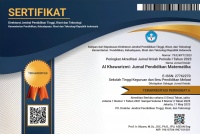OPTIMALKAN KEMAMPUAN SISWA DALAM MEMECAHKAN MASALAH MATEMATIKA DI SMP PUTRI CAHAYA MEDAN MELALUI IMPLEMENTASI PENDEKATAN GOAL FREE
DOI:
https://doi.org/10.46368/kjpm.v4i1.1805Abstract
Abstrak: Penelitian ini dilatarbelakangi oleh hasil-hasil penelitian terdahulu menunjukkan bahwa kemampuan siswa dalam memecahkan masalah matematika belum sesuai dengan yang diharapkan. Salah satu implementasi untuk meningkatkan kemampuan memecahkan masalah matematika ialah dengan pendekatan goal free. Tujuan penelitian ini adalah untuk mengetahui peningkatan kemampuan siswa dalam memecahkan masalah matematika melalui implementasi pendekatan goal free. Populasi dalam penelitian ini adalah siswa kelas VIII SMP Putri Cahaya Medan. Pengambilan sampel dilakukan secara purposive sampling, dan diperoleh 15 siswa sebagai sampel dalam penelitian. Instrumen penelitian yang digunakan adalah tes kemampuan pemecahan masalah matematis. Berdasarkan hasil analisis tersebut diperoleh kesimpulan bahwa : teknik pembelajaran melalui pendekatan goal-free problems sangat bagus untuk mendukung dan meningkatkan kemampuan memecahkan masalah siswa yang dimana siswa dapat menganalisa soal dengan baik, siswa dapat mengerti materi yang terdapat pada soal, dan siswa juga dapat berpikir kritis untuk menyelesaikan soal
Â
Kata Kunci: Kemampuan Memecahkan Masalah, Goal-Free Problems, Masalah Matematika
 Â
Â
Abstract : The study is set back by early study results showing that students' problem solving math is not what one would expect. One application to improve your ability to solve math problems is with a free goal approach. The purpose of this study is to see how the students' increased ability to solve mathematical problems through the implementation of a free goal approach. The population in this study is eighth graders of the junior high school princess of the field lights. Sample retrieval is strictly sampling, and enhanced by students as a sample in the research. The research instrument used was the mathematical problem-solving ability. Based on the results of these analyses, the conclusion is that the goal-free problems approach is essential to both support and improve students' ability to solve problems can solve problems well, students can understand the material on which to solve problems, and students can also think critically about problems.
Â
Keywords: Problem Solving Ability, Goal-Free Problems, Mathematics Problems Â
References
Halima, A. H., Triono A. M., (2022). Goal Free Evaluation. ISEEDU . 6 (2)
Fitriani, G., Darta. (2012). Pengaruh Pembelajaran Matematika Melalui Pendekatan Problem-Centered Learning (PCL) Terhadap Peningkatan Kemampuan Representasi Matematik Siswa SMP. Jurnal Pendidikan Matematika “SYMMETRYâ€. 1 (1).
Sumartini. (2015). Peningkatan Kemampuan Penalaran Matematis Siswa Melalui Pembelajaran Berbasis Masalah. Jurnal Pendidikan Matematika. 5 (1).
Sumartini, T. S.. (2016). Peningkatan Kemampuan Pemecahan Masalah Matematis Siswa melalui Pembelajaran Berbasis Masalah. Jurnal Pendidikan Matematika STKIP Garut. 5 (2).
Mardinah, Syarifuddin. (2018). Model-model Evaluasi Pendidikan. Jurnal Pendidikan & Konseling. 2(1).
Downloads
Published
How to Cite
Issue
Section
Citation Check
License
Authors who publish with this journal agree to the following terms:
1. Authors retain copyright and grant the journal right of first publication with the work simultaneously licensed under a Creative Commons Attribution License that allows others to share the work with an acknowledgement of the work's authorship and initial publication in this journal.
2. Authors are able to enter into separate, additional contractual arrangements for the non-exclusive distribution of the journal's published version of the work (e.g., post it to an institutional repository or publish it in a book), with an acknowledgement of its initial publication in this journal.
3. Authors are permitted and encouraged to post their work online (e.g., in institutional repositories or on their website) prior to and during the submission process, as it can lead to productive exchanges, as well as earlier and greater citation of published work.






